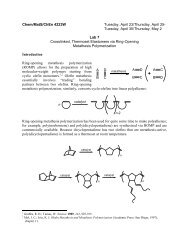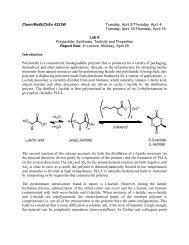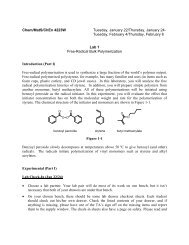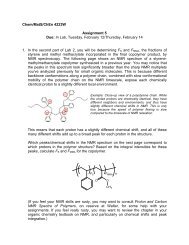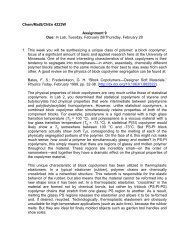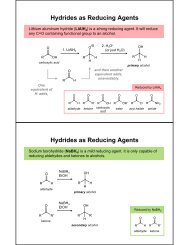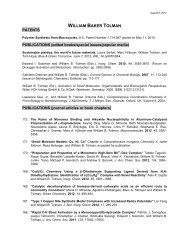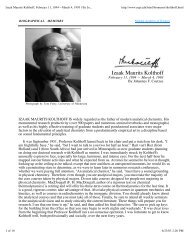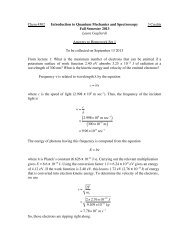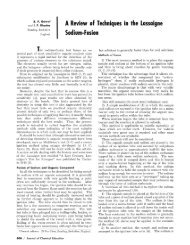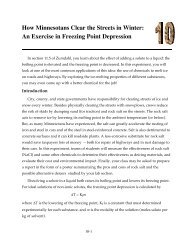Inverse Opal Photonic Crystals - Department of Chemistry ...
Inverse Opal Photonic Crystals - Department of Chemistry ...
Inverse Opal Photonic Crystals - Department of Chemistry ...
Create successful ePaper yourself
Turn your PDF publications into a flip-book with our unique Google optimized e-Paper software.
Overview<br />
This laboratory manual is designed to guide instructors and students in the preparation <strong>of</strong> inverse<br />
opal materials from beginning to end, including setup <strong>of</strong> equipment, preparation <strong>of</strong> polymer<br />
sphere templates, sol-gel templating to produce inverse opals, and study <strong>of</strong> optical properties.<br />
The best practices for successful results are given for each step, along with ordering information<br />
for specialized equipment. This lab exercise is recommended as a three-part experiment: Week 1<br />
- synthesize the polymer sphere templates; Week 2 - synthesize the inverse opals; Week 3 -<br />
explore the optical properties. Alternatively, the lab exercise can be organized as a two-part<br />
experiment if the polymer templates are prepared in advance by either a student group or the<br />
instructor.<br />
1. Introduction<br />
A. <strong>Opal</strong>s<br />
<strong>Opal</strong>s are among the most colorful <strong>of</strong><br />
all gems despite being composed<br />
primarily <strong>of</strong> silica, a colorless solid<br />
with the chemical formula SiO 2 (opals<br />
have the same chemical composition<br />
as window glass and quartz). Their<br />
name comes from the Latin word<br />
opalus meaning “to see a change <strong>of</strong><br />
color.” They exhibit a play <strong>of</strong> color<br />
(<strong>of</strong>ten called opalescence), which<br />
consists <strong>of</strong> iridescent color flashes that<br />
Figure 1. Photographs <strong>of</strong> opals displaying rainbows <strong>of</strong> colors<br />
that change as the angle <strong>of</strong> observation changes.<br />
change with the angle at which they are viewed (Figure 1). The effect is similar to the rainbow<br />
<strong>of</strong> colors observed on a soap bubble, only much more dramatic. The origin <strong>of</strong> iridescence in<br />
opals comes from an ordered microstructure <strong>of</strong> closely packed silica spheres, which causes light<br />
to diffract from the planes <strong>of</strong> spheres. Since the size <strong>of</strong> these silica spheres is on the order <strong>of</strong><br />
hundreds <strong>of</strong> nanometers, the wavelength <strong>of</strong> the diffracted light is also on the order <strong>of</strong> hundreds <strong>of</strong><br />
nanometers. This range <strong>of</strong> wavelengths falls within the visible region <strong>of</strong> light, spanning<br />
approximately 380 to 750 nanometers. Visible wavelengths are those that can be detected by our<br />
eyes, and they cover only a small portion <strong>of</strong> the electromagnetic spectrum, which also includes<br />
gamma-rays, X-rays, ultraviolet, infrared, microwaves, and radio waves (Figure 2).<br />
Diffraction <strong>of</strong> light from opals can cause flashes <strong>of</strong> any color <strong>of</strong> the rainbow, with the diameter<br />
and spacing <strong>of</strong> the silica spheres affecting the observed color. <strong>Opal</strong>s made <strong>of</strong> smaller spheres<br />
tend to display the violets and blues (which have shorter wavelengths), while those made <strong>of</strong><br />
larger spheres tend to display the reds (which have longer wavelengths). The more uniform the<br />
silica spheres with respect to size and arrangement, the more intense and defined the color.<br />
7



